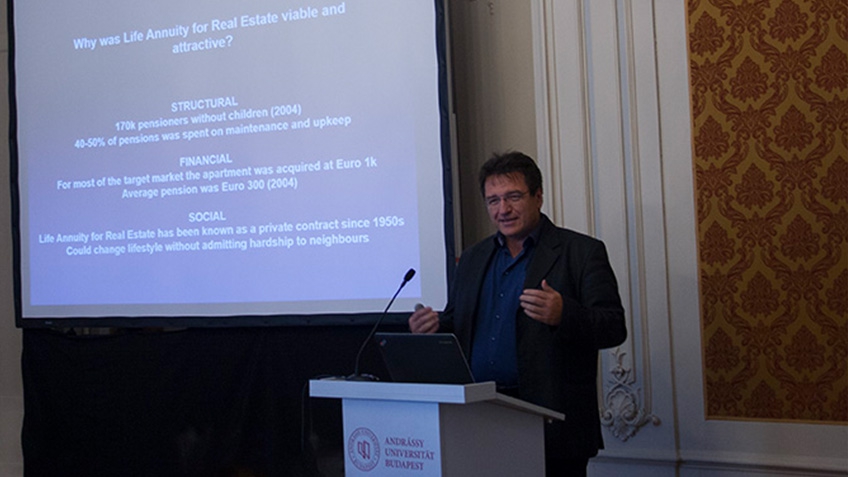On the 23rd of June, 2017 a stakeholder meeting (international expert meeting) with the title of The future of old age provision – demographic change, financial services and residential property was held at the Andrássy University Budapest. The aim of the meeting was to have a discussion with stakeholders on Equity Release Schemes (ERS) and its future possibilities - with a special focus on Hungary.
During the meeting the perspectives of the providers, the customers, the regulation and supervision as well as the academic sector were presented, thus the topic was discussed from the point of view of nearly all stakeholders involved. However, despite all our efforts, the representatives of the life insurance sector, future potential providers of the ERS products in the Hungarian market according to present Hungarian legislation, were absent.
The meeting started with the opening of Prof. Dr. Martina Eckardt from the Andrassy University Budapest (AUB) who welcomed the guests and pressed that the pension system in Europe is an important challenge to be solved.
The same was also emphasized by Prof. Dr. Dietmar Meyer, Rector of the AUB who, in his welcome address, underlined that new approaches and new solutions are essential for Europe to be able to support the elder people.
As the next presenter, Dr. Jörg Dötsch from the AUB, gave a short overview of the project Integrating residential property with private pensions in the EU[1], presenting its partnership, research objectives, first outcomes and some findings on the Hungarian market. Following to it, John Maher from the Waterford Institute of Technology, Ireland focused in his presentation on, among others, the retirement income pillars, the potential capital and income generation/ release from residential property and the different proposals that have been examined (e.g. unitised, leveraged, collective acquisition of residence rights with encashment of those rights post retirement, or, mortgage acquisition of residence with pension released from house, post retirement). Moreover, he pointed up some overall parameters and proposals to be discussed, such as desirability and feasibility, obstacles and enablers, beneficiaries/population cohorts, prerequisites for viability of the proposed solutions, scale of intervention and relative priority of interventions. He also emphasized that if we want a good model, the scale is very important.
The next speaker, Dr. József Hegedűs, CEO of the Metropolitan Research Institute, Budapest, gave an overview of the topic from the point of view of a sociologist. He referred to the integrating mechanism concept as articulated by Karl Polanyi (i.e. Polanyi’s work suggests that the market cannot be sustained without state regulation and a particular type of developed and ingrained social culture). Hegedűs also noted the impact Airbnb is having on the rental market in Hungary (shifting supply from conventional residential renting to short term tourist type renting). Hegedűs envisaged choices regarding three sources of solutions to housing and income/ living standards in retirement: state, market, family. Family solutions include a life support contract in exchange for tenancy or occupancy rights. Hegedűs characterised housing as a special commodity thus meriting particular consideration and treatment in a societal context. He also stated that privatising housing had the propensity of reinforcing or accelerating social inequality – look east for example to Russia. Moreover, he contrasted active earners (asset poor & cash rich) with retirees (asset rich & cash poor). Hegedűs also gave some insights on a 1998 study done in Hungary with respect to housing equity which found that a housing equity release product was not feasible. He also referred to a DEMHOW study which concluded that releasing housing equity was competing with family care solutions. Lastly, he mentioned a deepening gap between social classes emerging in Hungarian society and highlighted the distribution of income, housing wealth and arrears over different quintiles.
Further on, Imre Hild, co-founder of Hild Life Annuity and founder and managing CEO of OTP Life Annuity presented the experiences of equity release programmes in Hungary from the providers’ perspective. In his presentation, The Story of Life Annuity for Real Estate Model 2004-2009 in Hungary, he gave an overview on the main features of the life annuity for real estate programmes in Hungary and highlighted why such programmes could be viable and attractive in the country. As such, he grouped the reasons into three main groups: structural reasons (e.g. in 2004 there were 170,000 pensioners without children and 40-50% of pensions was spent on maintenance and upkeep), financial reasons (e.g. for most of the target market the apartment was acquired at Euro 1,000 and the average pension was Euro 300 in 2004) and social reasons (e.g. Life Annuity for Real Estate has been known as a private contract since 1950s and it could change the lifestyle of elderly without admitting hardship to neighbours). Summarizing the experiences of the 2.5-3 years of operation, he mentioned among others that the average age of the contracting parties was 71 years old; the average real estate value was HUF 12.4 million; among the contracted properties 60% were apartments, 30% were houses and 10% were weekend houses; the upfront payment was 25% of the value of the property at the beginning that rose up to 40% due to an increasing competition between different providers; and the average monthly annuity indexed by inflation was HUF 30,000. As for the overall results of the 2.5-3 years of operation, Hild indicated that approx. 5,000 clients / 4,000 properties were involved, HUF 13-14 billion in upfront payment was made and HUF 50 billion in real estate value were involved (this latest was a total by all the 3 providers that were present at the Hungarian market from 2004 until 2008, when the ERS programmes came to a halt in Hungary due to a real estate crisis brought along by the global financial crisis). Lastly, among the lessons learnt Hild mentioned that the key was to speak with the customer voice; the contract had to be a simple, no catch contract; security meant more than cash and that life annuity programmes saved lives and overall, it proved to be more than a simple financial programme, since it turned to become a social programme at least from the customers’ point of view. However, only part of the social problems raised by their clients could be fixed by a financial product like ERS, Hild stated.
The last presenter, László Kalmár, CEO of Europ Assistance Hungary ( a company active in the field of providing care and insurance services of life annuity programmes’ participants) presented the topic from the customers’ perspective. Apart from the presentation of his company’s activities, he gave an overview of the number of open cases since January 2014 and he also emphasized the importance of being able to speak with customer voice and taking care of some needs of the customers not being covered by the contract of the company too.
Finally, the stakeholder event was concluded with an open discussion, where participants also discussed the future of ERS programmes in Hungary. It was mentioned that since 2015 only insurance companies are allowed to offer ERS products in the country due to a change in the statutory requirements for operating such a business. However, there hasn’t been much interest from the insurance companies’ side so far, stated dr. Ferenc Szebelédi, head of the Insurance Supervision Department of the Central Bank of Hungary, representing the point of view of the regulation and supervision. All in all, participating stakeholders agreed that despite the present situation, the ERS market could evolve over time.
Erzsébet Czinger
[1] This project is funded by DG Employment, Social Affairs and Inclusion, VP/2014/014/0037



 ETN
QuickLinks
Contact
ETN
QuickLinks
Contact
 Start Your Studies!
Scholarships
Degree Programmes
PH.D. Programme
Admission
Alumni Association
Start Your Studies!
Scholarships
Degree Programmes
PH.D. Programme
Admission
Alumni Association
 Subscribe to our newsletter
Subscribe to our newsletter







